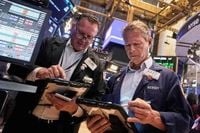Wall Street’s seemingly unstoppable rally hit the brakes this week, with U.S. stock indexes slipping for a second consecutive day on Wednesday, September 24, 2025. The S&P 500 fell 0.3%, the Dow Jones Industrial Average lost 0.4%, and the tech-heavy Nasdaq composite declined by 0.3%, according to the Associated Press and Investopedia. This modest retreat came after a string of record highs earlier in the week, leaving all three indexes still hovering near their all-time peaks set on Monday.
The recent run-up in stock prices has been nothing short of extraordinary. Since touching a low in April, the market has surged on optimism that President Donald Trump’s tariffs would not derail global trade and on hopes that the Federal Reserve would deliver several interest rate cuts to boost the economy. As AP reported, the rally was so pronounced that some investors began to worry about valuations becoming overstretched—especially if the Fed failed to deliver as many rate cuts as Wall Street anticipated.
Fed Chair Jerome Powell’s comments on Tuesday only added to the market’s cautious mood. Speaking in Rhode Island, Powell remarked that “equity prices are fairly highly valued,” echoing concerns reminiscent of Alan Greenspan’s famous “irrational exuberance” warning from the late 1990s. However, Powell tempered his assessment, stating, “it’s not a time of elevated financial stability risk.” Still, as Ed Yardeni of Yardeni Research noted in a commentary cited by CNBC, Powell’s words “triggered our contrary instincts,” reminding investors that financial crises often strike when exuberance is widespread and intensifying.
Wednesday’s trading session saw a broad-based pullback, with the S&P 500 Materials sector faring the worst, down 1.6%. Technology stocks also struggled, losing 0.5% as a group. Notably, tech giants Oracle and Nvidia each fell for a second straight day, down 1.7% and 0.8% respectively, while Amazon slipped 0.2% for its third consecutive decline. Micron Technology, a major player in the memory-chip market, dropped 2.8% despite posting record quarterly sales and issuing a bullish forecast. As AP observed, Micron’s shares had already soared nearly 98% in 2025, raising the bar for further gains.
Yet not all tech news was gloomy. Intel bucked the trend, jumping more than 6% after Bloomberg reported the company had discussed a potential stake sale to Apple. This gain added to a string of positive catalysts for Intel, including a recent 10% ownership stake taken by the U.S. government under President Trump and a $5 billion investment from Nvidia. Over the past month, Intel’s stock has surged more than 25%, aided by high-profile investments and a forecast for lower expenses, according to Investopedia.
Elsewhere, the S&P 500 Energy sector climbed 1.3%. Xcel Energy, EQT, and Phillips 66 led the way, up more than 6%, 4%, and 3%, respectively. West Texas Intermediate crude oil futures advanced 2.2% to about $64.80 per barrel, reflecting ongoing strength in the energy market.
Some of the day’s most dramatic moves came from companies tied to the battery and resource sectors. Lithium Americas, a Canadian firm developing a Nevada lithium project with General Motors, saw its shares nearly double—soaring 95.8%—after reports surfaced that the U.S. government was considering taking an ownership stake. Reuters quoted a White House spokesperson confirming President Trump’s support for the project, which is viewed as crucial to boosting domestic lithium production. The Department of Energy had previously approved a $2.26 billion loan for the project, but the Trump administration is now seeking to renegotiate terms over concerns about low lithium prices and repayment risks. Lithium Americas said it was in talks with both the Department of Energy and GM, with the government making “incremental requests” for additional conditions before releasing funds.
General Motors itself benefited from the lithium news, with its shares rising 2.3%. The move underscores the strategic importance of lithium for the U.S. auto and technology sectors, given that the mineral is a key component in rechargeable batteries. U.S. officials have grown increasingly wary of China’s dominance in the lithium supply chain, making domestic projects like Thacker Pass all the more critical.
Meanwhile, Freeport-McMoRan, a major mining company, suffered the S&P 500’s steepest drop, plunging 17%. The company lowered its third-quarter sales forecasts for copper and gold by 4% and 6%, respectively, citing operational setbacks at its Indonesian unit. A mud flow incident at the Grasberg mine tragically resulted in two worker fatalities and left five others missing, compounding the company’s challenges.
Homebuilders offered a rare bright spot. Lennar, PulteGroup, and D.R. Horton all advanced after a report showed new home sales in August exceeded economists’ expectations and even accelerated. Lennar climbed 2%, PulteGroup rose 0.7%, and D.R. Horton added 0.7%, according to AP and Barchart.
Other notable movers included Alibaba, which surged 8% after announcing it would boost its AI infrastructure budget beyond $53 billion, intensifying competition with U.S. chipmakers like Nvidia. Marvell Technology rose more than 7%, and Centene, a health insurer, gained 5.8% after positive news on cost controls and value-based care incentives.
In commodities, gold futures retreated 1.5% to $3,765 an ounce, pulling back from a record high set earlier in the day. The 10-year Treasury yield edged up to 4.15% from 4.11% on Tuesday, reflecting rising borrowing costs across the economy. Bitcoin, meanwhile, climbed 1.6% to around $113,500, and the U.S. dollar index rebounded 0.6% to 97.87 after hitting lows not seen since early 2022.
Internationally, market performance was mixed. Hong Kong’s Hang Seng Index jumped 1.4%, while France’s CAC 40 fell 0.6%. These moves highlighted the global nature of recent volatility, as investors worldwide reassessed risk in light of shifting central bank policies and economic data.
Despite the pause, the prevailing mood on Wall Street remains one of cautious optimism. The S&P 500 closed at 6,637.97, the Dow at 46,121.28, and the Nasdaq at 22,497.86. While some sectors faltered and high expectations weighed on certain stocks, the broader market’s resilience suggests investors are still betting on a favorable economic backdrop—at least for now.
As the dust settles from this week’s volatility, all eyes will be on the Federal Reserve’s next moves, corporate earnings, and whether the market’s optimism can withstand the test of reality. For now, Wall Street’s rally may have cooled, but the conversation about valuations, government intervention, and global competitiveness is only heating up.






